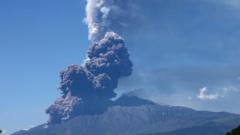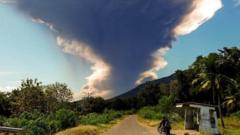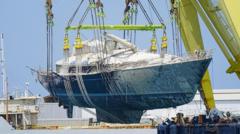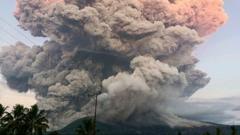On the morning of Monday, images and videos emerged of one of the world's most active volcanoes, Mount Etna, erupting, with large clouds of volcanic ash and smoke visible. The eruption, reported by Italy's National Institute of Geophysics and Volcanology (INGV), was characterized by a series of explosions of "increasing intensity" during the early hours. As of now, while the eruption's full impact is still being assessed, the disruption appears minimal, indicating that Mount Etna's eruptions, frequent as they are, rarely result in significant harm.
Mount Etna Erupts: Spectacular Ash Plumes Emanate from Sicilian Volcano

Mount Etna Erupts: Spectacular Ash Plumes Emanate from Sicilian Volcano
Mount Etna in Sicily has erupted, sending dramatic plumes of ash and smoke high into the sky, capturing international attention.
The geophysical monitoring conducted by INGV indicated that the eruption occurred predominantly from the southeastern flank of the volcano, at a notable vent measuring about 200 meters wide. Videos circulating on Monday captured a rapid release of ash, gas, and rock—a phenomenon known as pyroclastic flow—moving down the volcano's slope. Geologists surmise that a portion of the volcano's crater may have collapsed, contributing to the volcanic material's descent. Although pyroclastic flows can pose serious risks, authorities have reported no immediate threats to surrounding areas.
The INGV stated that the volcanic material had advanced only as far as the Valley of the Lion, which serves as a common point for tourists approaching the summit. Initial activity changes were detected at 12:39 AM local time, leading to the announcement of an ongoing "Strombolian" eruption. These eruptions, marked by intermittent explosive activity, stem from gas accumulation in the magma chamber, where sudden gas releases can propel volcanic material into the air. Such eruptions pose a particular threat to air travel.
Earlier reports indicated a red alert issued on Monday, potentially affecting nearby flights, though this alert has since been downgraded. Mount Etna’s last significant eruption occurred in February, causing disruptions at Catania airport as ash clouds forced numerous flight diversions. Tourists have also been advised to steer clear of the volcano and its lava flows for safety.
The latest eruption at Mount Etna underscores the ongoing volcanic activity in the region while highlighting the need for precautions during such natural phenomena.
With vigilant monitoring and timely alerts, authorities aim to mitigate risks associated with this powerful and unpredictable natural landmark.
The INGV stated that the volcanic material had advanced only as far as the Valley of the Lion, which serves as a common point for tourists approaching the summit. Initial activity changes were detected at 12:39 AM local time, leading to the announcement of an ongoing "Strombolian" eruption. These eruptions, marked by intermittent explosive activity, stem from gas accumulation in the magma chamber, where sudden gas releases can propel volcanic material into the air. Such eruptions pose a particular threat to air travel.
Earlier reports indicated a red alert issued on Monday, potentially affecting nearby flights, though this alert has since been downgraded. Mount Etna’s last significant eruption occurred in February, causing disruptions at Catania airport as ash clouds forced numerous flight diversions. Tourists have also been advised to steer clear of the volcano and its lava flows for safety.
The latest eruption at Mount Etna underscores the ongoing volcanic activity in the region while highlighting the need for precautions during such natural phenomena.
With vigilant monitoring and timely alerts, authorities aim to mitigate risks associated with this powerful and unpredictable natural landmark.


















